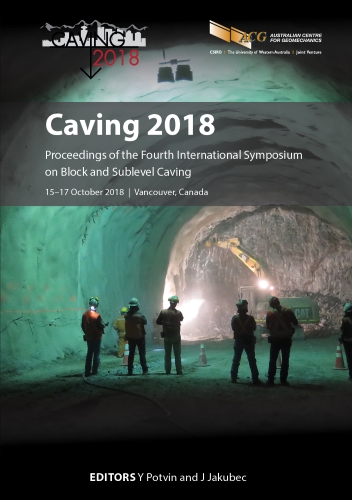Analysis of damaging seismic event on 24 December 2011 in the Pilar Norte sector of El Teniente mine

|
Authors: Malovichko, D; Cuello, D; Rojas, E |
DOI https://doi.org/10.36487/ACG_rep/1815_49_Malovichko
Cite As:
Malovichko, D, Cuello, D & Rojas, E 2018, 'Analysis of damaging seismic event on 24 December 2011 in the Pilar Norte sector of El Teniente mine', in Y Potvin & J Jakubec (eds), Caving 2018: Proceedings of the Fourth International Symposium on Block and Sublevel Caving, Australian Centre for Geomechanics, Perth, pp. 637-650, https://doi.org/10.36487/ACG_rep/1815_49_Malovichko
Abstract:
Numerous tunnels of the extraction and undercut levels of the Pilar Norte sector experienced violent damage on 24 December 2011. A seismic event with a moment magnitude of 2.4 was recorded by the mine-wide seismic system at the same time. It is difficult to explain the observed damage with peak particle velocities/peak ground velocities calculated for the basic source parameters of this event (location and magnitude). Seismic data recorded in Pilar Norte in 2011 indicate that failure in the sources is driven by sub-vertical compressional stress. The majority of seismic events located around the undercut level have crush-type source mechanisms (significant implosive component, pancake-shaped deviatoric parts with sub-vertical P-axis) evidencing vertical convergence of the excavations. There are no clear indications of active planar geological structures in the seismic data. The large seismic event that occurred on 24 December 2011 during the blasting sequence and its waveforms are complex. The source mechanism estimated from the low frequency part of the waveforms is of a crushtype. It was hypothesised that the source of this event represents a cascading damage of tunnels. The hypothesis was tested by means of comparing the modelled waveforms of spatially distributed episodes of tunnel damage with the recorded waveforms. A reasonable match was obtained for the scenario including an initial 20 mm convergence of the extraction and undercut drives around the southern Pilar Norte undercut front at a rate of 0.6–0.8 m/s and subsequent spread of smaller (3–6 mm) convergence along the eastern Pilar Norte undercut front and eastern Sub 6 cave abutment at a rate of 0.2–0.4 m/s. There was also significant shearing (ride) deformation along the southern and eastern Pilar Norte cave front. The hypothesis of cascading damage of tunnels also agrees with the underground observations (more than 90% of damage was attributed to the side walls of tunnels) and predictions of sub-vertical orientation of maximum principal stress around the tunnels of the extraction level according to a numerical stress model.
Keywords: seismic source mechanism, mechanism of damage, cascading damage of tunnels
References:
Aki, K & Richards, P 2002, Quantitative Seismology, 2nd edn, University Science Books, Herndon, 700 p.
Bolt, BA & Abrahamson, NA 2003, ‘Estimation of strong seismic ground motions’, in WHK Lee, H Kanamori, PC Jennings & C Kisslinger (eds), International Handbook of Earthquake and Engineering Seismology, vol. B, Academic Press, Cambridge, pp. 983–1001.
Dunlop, R & Belmonte, A 2005, ‘The April 22nd, 2003 rockburst in the Sub 6 sector, El Teniente mine – A case study’, in Y Potvin & M Hudyma (eds), Proceedings of the 6th International Symposium on Rockbursts and Seismicity in Mines, Australian Centre for Geomechanics, Perth, pp. 291–297.
Hanks, TC & Kanamori, H 1979, ‘A moment magnitude scale’, Journal of Geophysical Research, vol. 84, no. 5, pp. 2348–2350.
Ide, S 2007, ‘Slip inversion’, in G Schubert (ed), Treatise on Geophysics, Volume 4: Earthquake Seismology, Elsevier, New York,
pp. 193–223.
Kaiser, PK & Maloney, SM 1997, ‘Scaling laws for the design of rock support’, Pure and Applied Geophysics, vol. 150, no. 3–4,
pp. 415–434.
Kaiser, PK, McCreath, DR & Tannant, DD 1996, Canadian Rockburst Support Handbook, Canadian Mining Industry Research Organization, Sudbury.
Leiva, CE & Duran, L 2003, ‘Pre-caving, drilling and blasting in Esmeralda Sector of El Teniente mine’, Fragblast, vol. 7, no. 2,
pp. 87–104.
Malovichko, D & Meyer, S 2017, El Teniente Mine: Analysis of Influence of Mining Factors on Seismic Hazard Characteristics in the Reservas Norte Sector, technical report, Institute of Mine Seismology, Hobart, 56 p.
Malovichko, D, van Aswegen, G & Clark, R 2012, ‘Mechanisms of large seismic events in platinum mines of the Bushveld Complex (South Africa)’, The Journal of The Southern African Institute of Mining and Metallurgy, vol. 112, pp. 419–429.
McGarr, A 1984, ‘Scaling of ground motion parameters, state of stress, and focal depth’, Journal of Geophysical Research, vol. 89, no. B8, pp. 6969–6979.
Mendecki, AJ 1997, Seismic Monitoring in Mines, Chapman and Hall, London, 262 p.
Olson, A & Apsel, R 1982, ‘Finite faults and inverse theory with applications to the 1979 Imperial Valley earthquake’, Bulletin of the Seismological Society of America, vol. 72, pp. 1969–2001.
Rojas, E & Balboa, S 2017, ‘Keynote lecture: Management of seismic risk in high stress conditions, El Teniente mine’, in JA Vallejos (ed), Proceedings of the 9th International Symposium on Rockbursts and Seismicity in Mines, University of Chile, Santiago, pp. 280–289.
Vavrycuk, V & Kuhn, D 2012, ‘Moment tensor inversion of waveforms: a two-step time-frequency approach’, Geophysical Journal International, vol. 190, no. 3, pp. 1761–1776.
Wiles, T 2010, Map3D, computer software, Map3D International Ltd, https://www.map3d.com
© Copyright 2025, Australian Centre for Geomechanics (ACG), The University of Western Australia. All rights reserved.
View copyright/legal information
Please direct any queries or error reports to repository-acg@uwa.edu.au
View copyright/legal information
Please direct any queries or error reports to repository-acg@uwa.edu.au
